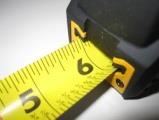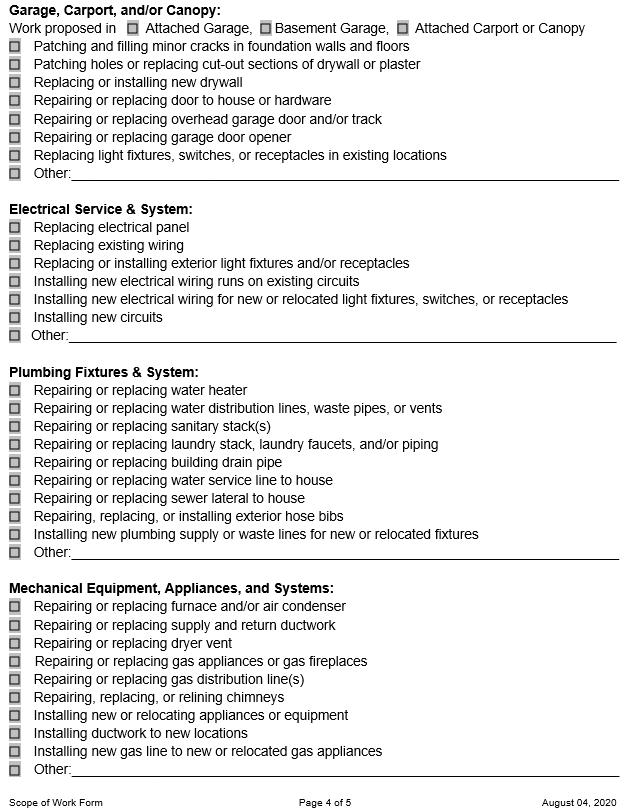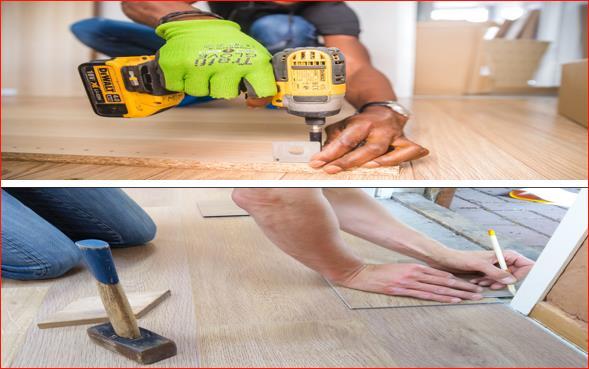NOTICES Regarding Permits
This Checklist provides basic information for a permit to repair or renovate a damaged house where materials and labor costs are shown in the submittal to be less than 50% of the existing residence’s predamage market value. House damage may require a permit to repair or replace when the result of:
1. Natural disaster, such as damage from fire, wind, flood or earthquake, and/or;
2. Neglect, or where regular maintenance has not been performed.
• Contact our office at the outset (call the Permits Processing number noted on the cover) to help you determine how feasible it would be to repair, renovate as well as alter a substantially damaged structure. Where feasible, be aware complete sets of drawings properly sealed by a Missouri Registered Design Professional may be required.
• Be aware there are zoning, building construction, and flood plain management code regulations that may impact the repair, renovation, remodeling and/or alteration of a substantially damaged structure, which is damaged 50% or more of the existing dwelling’s pre-damage market value
• A permit is not required for minor repairs or for regular, routine maintenance See St. Louis County’s list on-line regarding “When is a Building Permit Required for Residential Projects?” It actually lists maintenance and repairs NOT requiring a permit.
• Repair is considered the patching, restoration or replacement of minor and non-structural materials, elements, and/or components. One example is a like-for-like replacement of existing kitchen cabinets/countertops in their same location and configuration (SLCO Policy)
• It is recognized the applicant will often include renovation, alteration, or reconstruction new work with the repairs required to bring the residence to a particular state for re-occupancy or re-sale.
• Like-for-like repairs or replacements that require a permit may not require a drawing submittal The Inspector will determine whether or not drawings are required upon completion of a scheduled site inspection before building plan review begins. Complete the Applicant section of the ‘Preliminary Damages Inspection Report’ form included in this Checklist, and submit it with the permit application.
• NOT like-for-like replacements and/or renovations, remodeling, and alterations proposed with likefor-like replacements and repairs require a permit and drawings submittal. See other St. Louis County Checklists for code and ordinance requirements that are applicable, such as:
1. Kitchen & Bath Remodeling;
2. Factory-Built Fireplaces & Stoves;
3. Finished Basements;
4. Room Additions
• New work renovation, alteration, and reconstruction requires a permit with drawing submittal. Some examples are listed below:

1. Reconfiguring or altering space(s) or rooms;
2. Providing opening(s) for door(s) or window(s);
3. Reconfiguring kitchen countertops, cabinets and/or appliances;
4. Reconfiguring an existing bathroom;
5. Reconfiguring or extending any system;
6. Adding new equipment or fixtures;
7. Altering existing structural (load-bearing) elements, or adding them.
• Repairs, renovation and alteration new work often require electrical plumbing and/or mechanical work be provided with it. For such residential within Unincorporated St. Louis County - and in those Municipalities contracting fully with the County for its Code Enforcement Services – building,
2 of 14
electrical, mechanical, and plumbing are provided in an integrated permit at issuance. This means 1 permit is used for all disciplines and for the entire new work project. The cost for construction, mechanical, electrical, and plumbing is less in an integrated permit than the total cost would be for separate permits of each discipline. Sub-contractors are required to sign-on to the permit after it is issued and before the work starts
• Electrical and plumbing work shall be performed, in accordance with St. Louis County Codes sand Ordinances, by licensed electrical contractors and licensed master plumbers who have registered with the St. Louis County Dept. of Public Works-Code Enforcement. A pre-authorized homeowner who - by examination administered by St. Louis County Inspections - has demonstrated the knowledge and ability to perform the work, may perform his/her own electrical and/or plumbing work.
• Mechanical work shall be performed by a licensed contractor authorized to do residential mechanical work and who has registered with the St. Louis County Dept. of Public Works-Code Enforcement. Homeowners may perform mechanical work in their own dwelling with no requirement to be licensed.
• The applicant (property owner or the Contractor) is responsible for contacting those agencies that may be affected by the new work, or that may have legal oversight of the new work along with but separate from St. Louis County. Where requirements among the agencies conflict, the most restrictive shall govern the new work. Contact these agencies before beginning work approved under a permit issued by St. Louis County. Such agencies may include:
1. The project site’s Municipality;
2. The Local Fire Protection District;
3. The Electric Company;
4. The Sewer District; and
5. Subdivision Trustees.
• Permit issuance for the project does not automatically authorize construction access to that project site. If a project site’s driveway entrance is unavailable for construction access or none exists, the property owner or authorized Contractor must apply for a permit with the Owner of the Right-of-Way (may be the County’s Highway Dept. or the Municipality) to construct a temporary entrance.
• Project-specific site plan(s) submitted with the permit application should include the following:
1. Draw an arrow over the property’s existing driveway, and point it into the lot. Label the arrow as “Construction Entrance”; OR
2. Draw an arrow over a proposed alternate access location, and point it into the lot. Label the arrow as “Construction Entrance”. Note on the site plan: “A separate special use permit for a construction entrance will be obtained from the street right-of-way owner before the start of construction access to the project site”.
• Structural drawing set required shall be properly sealed by a Missouri registered architect or engineer. The top sheet of each submittal set shall be dated and stamped with an electronic seal and signed by the design professional. Subsequent sheets in the set shall have the design professional’s electronic seal. The drawing set shall bear the name, business and email addresses and contact number(s) of the architect or engineer (B107.1; SLCO Policy)
• Structural calculations required shall have a dated cover page properly sealed with an electronic seal and signed by a Missouri registered architect or engineer. Subsequent pages shall be sequentially numbered and totaled each page, starting with the cover as page 1. The cover page shall have the name, address and contact/phone number of the registered design professional (R301.1; R301.1.1; R301.1.3; B107.1; SLCO Policy).
• The Plan Reviewer may determine the proposed work, construction, or conditions require additional drawings and information be submitted to Code Enforcement-Plan Review for review, beyond the minimum submittal requirements noted in this Checklist.
3 of 14
Submittal Requirements: Construction-Ready Drawings, Their General Notes of Construction, & Zoning

Submit the electronic set of drawings that are labeled, fully-dimensioned, and drawn to a scale. Also submit other documents in quantities as noted below Where noted, submit properly sealed drawings and properly sealed calculations (B107.2.1; SLCO Policy):
• Electronic Building Permit Application filled out, signed and dated by the applicant
• Electronic Preliminary Damages Inspection Report Form, provided in this Checklist Inspector will use it on a scheduled site visit to verify or note scope of work conditions apparent and then provide it to building plan review to issue the permit or require more information that may need to be sealed by a Missouri registered engineer or architect.
• Electronic Scope of Work form, provided in this Checklist) Also see other residential checklists applicable to new work proposed.
• Zoning Approval
1. Municipality: Submit electronic set of plan(s) that have been electronically stamped-Approved, Signed Dated by the Municipality’s Zoning Officer, and submit the completed Zoning application form that has been approved, signed and dated by Zoning Officer (B107.2.5; SLCO Revised Ord. R107.1);
2. Unincorporated St. Louis County: Submit electronic set of plans or site plans as noted below. Site plans noted below are required where the new work changes the dwelling’s footprint/outline:
a. Draw lot layout and dimension the property lines, show North with an arrow. Note the lot number and subdivision name. Dimension and label setbacks and easements.
b. Show and label by function any existing buildings on the lot.
c. Dimension the outlines of the dwelling and dimension and show with heavy line or with dashed line the new work extension or bump-out. Dimension any new work roof overhangs projecting more than 18”.
d. For residences on properties in a Flood Hazard Area, Before occupancy is granted of a dwelling within a 100-year flood elevation, submit a Letter of Map Revision (LOMR) obtained from FEMA, in which is noted the removal of building or structure from the special flood hazard area (SLCO Revised Ord. R110.1; B110.3.14.1).
• Architectural Drawings (B107.1 & SLCO Policy).
For repair-only work requiring a permit, submit the following in electronic set, at a minimum:
1. Detailed room-by-room list of the work required in each room, and;
2. Detailed list of the work required at the exterior of the residence, and;
3. Where many repairs are proposed throughout most of the house, submit completed the comprehensive “Scope of Work Form” included in this Checklist OR
4. Detailed claim evaluation from an insurance company of the work required; OR
5. Detailed itemized bid estimate from a contractor of the work required.
For repair work with renovation, alteration, or reconstruction new work, submit the following in an electronic set, at a minimum. Drawings are typically required to be electronically sealed by a Missouri registered architect or engineer. Sealed structural calculations may also be required:
1. Notice: See other St. Louis County Residential Checklists applicable to the new work proposed, and follow their requirements noted.
4 of 14
OR
2. An electronic comprehensive list of required repairs, noted on the plans or separately with project address, owner names noted

3. Required Electronic Drawings, which may include the following (B107.2.1; SLCO Policy):
a. Interior Finish Plans locating and identifying the construction, plumbing, electrical and/or mechanical work and naming the rooms and spaces. Dimension rooms and spaces, and label new work and existing-to-remain items for clarity; scale 1/4”=1’-0” typical.
b. Framing Plans for new work proposed – like replacing or altering framing members providing new work floor openings - or to show loads at, or bearing upon, or supporting altered or removed or added walls or other structures. Framing plans required may include floors, ceilings, roofs, lofts, or mezzanines. Label framing members, their size(s), quantities, spacing, and grades; scale 1/4”=1’-0” typical
c. Building Section-Elevations for Interior Alterations show and identifying the loads and load pass above and below alterations, such as interior walls opened, altered, or added Extend the section-elevation(s) from top of roof to soils. Drawings typically required to be sealed by a Missouri registered architect or engineer. Sealed structural calculations may also be required; scale 1/4”=1’-0” typ.
d. Wall Construction/Assembly & Structural Framing Sections – as applicable to new work; show extent from floor-to-floor structure and/or from floor-to-ceiling structure. Drawings typically required to be sealed by a Missouri registered architect or engineer; scale 1/2” to 3/4”=1’-0” .
e. Structural Connection Section Details - as applicable to new work. Drawings typically required to be sealed by a Missouri registered architect or engineer; scale 1/2” to 1-1/2”=1’-0”
f. Truss Profile Drawings & Layouts where proposed as new work, or for existing trusses to be repaired or altered. Structural truss profile drawings shall be properly sealed by a Missouri registered professional engineer. Repair or alteration drawings shall be properly sealed and submitted with set of properly sealed structural calculations (SLCO Rev. Ords. R502.11.1; R502.11.4; R802.10.1; R802.10.2).
g. Electrical Layout - Show and label in affected rooms and spaces on the architectural plans the locations of new work and existing-to-remain (ETR) receptacles, switches, lights, ceiling fans, and exhaust fans. Identify/label 240 volt receptacles/circuits. Draw curved lines from wall switches and lighting receptacles to show the lights they each control
h. Plumbing Layout – Show and label locations in affected rooms and spaces on the architectural plans the new work and existing-to-remain (ETR) fixtures including kitchen sink, dishwasher, refrigerator, bar sink, lavatory, water closet/toilet, bathtub, shower, hot water heater, floor drain, hose bib, and plumbing chases (SLCO Rev. Ord. P1103.P-136)
i. Mechanical Plan(s), Section Details for Gas Appliances not High-Efficiency, & Whole House Heat Gain/Loss Calculations – Required for new work, and where like-for-like replacement was not verified by Inspector.
Design, Construction & Finish Requirements Drawings Content
The following are some of the minimum requirements to be provided for Repairs & Renovations to an existing residence. They are to be noted and provided in drawings submitted for a permit, as applicable:
General Requirements
Where applicable to the new work, the following are to be provided. See St. Louis County’s Residential Checklists for more information and requirements:
5 of 14
• Show and label existing walls removed or modified as bearing or non-load bearing in the plans. Also submit framing plans of the structure above, where distributed and point loads are applied to the structures below. Alterations to bearing walls must be submitted in structural drawings and calculations properly sealed by a Missouri architect or engineer. Beam deflection analysis may be required (R301.1; R301.1.1; R301.1.3).
• Non-load bearing partitions shall be minimum 2x4 framing at 16” or 24” o.c. with bottom and top plates and minimum 1/2” gypsum board finish both sides (R702.3; R702.3.2)
• Fireblocking of 2" lumber, 23/32" structural wood panel or other approved materials (R302.11; R302.11.1).
• Insulation already existing in exposed exterior framing may remain. Where NO insulation exists, provide minimum R-15 insulation in exterior frame walls, minimum R-19 insulation in floors over crawl spaces, and minimum R-38 insulation in ceilings below unconditioned space (N1101.5; SLCO Rev. Ord. Table N1102.1.2).
• Keep any foam plastic insulation packaging for new work on-site and readily available to the St. Louis County Inspector (R302.8; R316):
• Interior finish materials shall have a maximum flame spread index of 200 and a maximum smoke development index of 450 (R302.9).
Smoke & Carbon Monoxide Alarms
With Residential Repairs & Renovations, residence smoke and carbon monoxide alarm systems shall be verified as, or shall be made compliant with, 2015-IRC requirements as follows (R314; R315):
• Smoke alarms AC-powered and with battery backup, compliant with NFPA 72, and listed in accordance with UL 217 (R314.1; R314.1.1)
• Place smoke alarms (R314.3):
1. In each sleeping room between the room’s entrance and the bed;
2. Outside the sleeping room (like a hallway), and in the immediate vicinity of the entry to each separate sleeping room and upstream from any return air grille;
3. On floor levels with no sleeping rooms or bedrooms, such as basements and habitable attics.
4. On the upper level of a split level dwelling without a door between the levels and where the adjacent lower level is less than 1 full story below the upper level.
5. On both levels of a split level dwelling where a door intervenes between levels, or where the levels are 1 full story apart.
• Where more than 1 smoke alarm is required within a dwelling unit, interconnect alarm devices so that activation of 1 alarm will activate all alarms throughout the dwelling unit (R314.4).
• Provide a carbon monoxide alarm outside of each sleeping area and bedroom in their immediate vicinity in a dwelling with a fuel-fired appliance or with an attached or basement garage (R315.2; R315.3).
• Provide a carbon monoxide alarm in a bedroom in the space between a bed and a fuel-burning appliance, including appliances in a bathroom that opens to the bedroom (R315.3).
• Carbon monoxide alarms shall be allowed in an existing residence as follows (R315.2.2; R315.5):
1. Battery operated; OR
2. AC-powered, with primary power from the building’s wiring served by a commercial source, and have battery backup.
• Carbon monoxide alarms shall be listed in accordance with UL 2034. Combination carbon monoxide/smoke alarms shall be listed in accordance with UL 2034 and UL 217 (R315.1.1)
6 of 14
Primary Egress
• Where the new work changes the existing rough opening to the Primary Egress/entry door, the clear opening must be minimum 32” x78” for a minimum 3’ -0” wide door leaf that is side-hinged. Where rough openings are changed for double-leaf doors labeled as Primary Egress, 1 of the 2 door leafs must comply with the door width and clear opening requirements noted (R311.2; SLCO Policy).
• Where the new work replaces the Primary Egress/entry door or its lock is replaced, the new lock shall allow the door to open from inside without use of a key, special knowledge or effort; and any allowed inside key operation shall not allow key removal when locked from the inside. Locks with thumb turns on the inside are permitted (R311.2; SLCO Policy).
Emergency Escape
• Each altered, reconfigured or added habitable attic, bedroom and sleeping room shall have at least 1 emergency escape opening that meets the following minimums (R310):
1. Maximum height to bottom of clear opening - 44"
2. Minimum net clear opening width - 20"
3. Minimum net clear opening height - 24"
4. Minimum 5.7 sq. ft net clear opening. Minimum 5 sq. ft. net clear opening for grade floor windows
5. The required net clear opening area shall be met by normal window operation from inside dwelling, and shall not require the use of keys, tools or special knowledge.
Mechanical
See other St. Louis County Residential Checklists applicable to the new mechanical work proposed or required. The Checklists are available from St. Louis County’s website under Public Works.
• Where new work is not a like-for-like replacement, or the Inspector was not contacted to observe existing HVAC before it was removed, provide in required drawings the labeled furnace location and type (such as fan-assisted induced draft or natural draft); source of combustion air; flue size(s); duct sizes and locations; supply and return air grilles; and a programmable thermostat for each heating and cooling system and/or zone (B107.4; G2426; G2427; M1601.1.2; N1103.1; SLCO Policy).
• In bathroom(s) and/or toilet room(s) with proposed new work , show and note a minimum 50 CFM fan exhausted to the exterior (M1507.2, M1507.3, & P303.3; SLCO Rev. Ord. R303.3; M1501.1-Excp. 2). See St. Louis County’s Kitchen and Bath Remodeling Checklist for more on the above and other requirements.
• For a remodeled or reconfigured kitchen, show and note the cooktop or range has a listed hood exhausted to the exterior with a minimum 100 CFM fan for intermittent use; OR show and note a listed and labeled recirculating ductless range hood. See St. Louis County’s Kitchen and Bath Remodeling Checklist for more on the above and other requirements (M1507.4; R303.1; SLCO Rev. Ord. M1503.1).
Electrical
See other St. Louis County Residential Checklists applicable to the new electrical work proposed or required. The Checklists are available from St. Louis County’s website under Public Works.
• Receptacles new work (E210-52):
1. In bedrooms, provide as Arc-Fault Circuit Interrupted (AFCI);
2. In bathrooms, provide as GFCI, and at least 1 wall-mounted within 36" of each lavatory basin rim.
3. In habitable rooms, provide so that no space along a wall is more than 6'-0" from a receptacle.
• Lighting new work ((E210.70; M1305.1.3.1; SLCO Rev. Ord. M1305.1.4.3):
1. At least 1 wall switch-controlled lighting outlet for new electrical work in rooms and spaces that are habitable room(s), kitchen, bathroom, and/or hallway.
2. At least 1 wall switch-controlled lighting outlet for new electrical work at each floor level of interior stairways, exterior entryway, and at exterior doors.
7 of 14
Plumbing
See other St. Louis County Residential Checklists applicable to the new plumbing work proposed or required. The Checklists are available from St. Louis County’s website under Public Works.
Notice:
The items in this House Repairs & Renovations Checklist cover the major points for compliance relative to new work requiring a permit, and new work requiring drawings submitted with a permit application for review. Drawings will be reviewed for completeness and code compliance. Where clarification or more information is required, the Plan Reviewer will so inform the Applicant. Achieving compliance with this Checklist does not mean, for the work proposed, all code requirements a Plan Reviewer may expect to see addressed in a set of drawings has been provided. The St. Louis County Inspector may flag code requirements to be met as the Inspector completes the ‘Preliminary Damages Assessment Report’ in the field, after the permit application is submitted, and before the permit is approved for issuance. Also, many code requirements are flagged and then met in the field through the process of St. Louis County Inspections of construction or installation.
It is the applicant's responsibility to obtain all permits and approvals required for the proposed repair and/or renovation work. In addition to contacting the Louis County Department of Public Works-Code Enforcement, the applicant should check with the St. Louis County Department of Transportation-Civil Plan Review; the Sewer District; the project site’s Local Fire Protection District; the project site’s local Municipality (if not in an Unincorporated area of St. Louis County); and any Subdivision Trustees. Other enforcement agencies may have requirements more restrictive or in addition to those required by St. Louis County.
8 of 14

9 of 14

10 of 14

11 of 14

12 of 14

13 of 14

14 of 14











